Attached files
| file | filename |
|---|---|
| 8-K - PDL BIOPHARMA 8-K 6-27-2011 - PDL BIOPHARMA, INC. | form8k.htm |
Exhibit 99.1

1
RBC
Non-Deal Roadshow
Non-Deal Roadshow
June 27-30, 2011

Forward Looking Statements
This presentation contains forward-looking statements, including PDL’s expectations with respect to its future royalty
revenues, expenses, net income, and cash provided by operating activities.
revenues, expenses, net income, and cash provided by operating activities.
Each of these forward-looking statements involves risks and uncertainties. Actual results may differ materially from those,
express or implied, in these forward-looking statements. Factors that may cause differences between current expectations
and actual results include, but are not limited to, the following:
express or implied, in these forward-looking statements. Factors that may cause differences between current expectations
and actual results include, but are not limited to, the following:
▪ The expected rate of growth in royalty-bearing product sales by PDL’s existing licensees;
• The relative mix of royalty-bearing Genentech products manufactured and sold outside the U.S. versus manufactured
or sold in the U.S.;
or sold in the U.S.;
• The ability of PDL’s licensees to receive regulatory approvals to market and launch new royalty-bearing products and
whether such products, if launched, will be commercially successful;
whether such products, if launched, will be commercially successful;
• Changes in any of the other assumptions on which PDL’s projected royalty revenues are based;
• Changes in foreign currency rates;
• Positive or negative results in PDL’s attempt to acquire royalty-related assets;
• The outcome of pending litigation or disputes, including PDL’s current dispute with Genentech related to ex-U.S. sales
of Genentech licensed products; and
of Genentech licensed products; and
• The failure of licensees to comply with existing license agreements, including any failure to pay royalties due.
Other factors that may cause PDL’s actual results to differ materially from those expressed or implied in the forward-
looking statements in this presentation are discussed in PDL’s filings with the SEC, including the "Risk Factors" sections
of its annual and quarterly reports filed with the SEC. Copies of PDL’s filings with the SEC may be obtained at the
"Investors" section of PDL’s website at www.pdl.com. PDL expressly disclaims any obligation or undertaking to release
publicly any updates or revisions to any forward-looking statements contained herein to reflect any change in PDL’s
expectations with regard thereto or any change in events, conditions or circumstances on which any such statements are
based for any reason, except as required by law, even as new information becomes available or other events occur in the
future. All forward-looking statements in this presentation are qualified in their entirety by this cautionary statement.
looking statements in this presentation are discussed in PDL’s filings with the SEC, including the "Risk Factors" sections
of its annual and quarterly reports filed with the SEC. Copies of PDL’s filings with the SEC may be obtained at the
"Investors" section of PDL’s website at www.pdl.com. PDL expressly disclaims any obligation or undertaking to release
publicly any updates or revisions to any forward-looking statements contained herein to reflect any change in PDL’s
expectations with regard thereto or any change in events, conditions or circumstances on which any such statements are
based for any reason, except as required by law, even as new information becomes available or other events occur in the
future. All forward-looking statements in this presentation are qualified in their entirety by this cautionary statement.
2

|
Company
|
PDL BioPharma, Inc.
|
|
Ticker
|
PDLI (NASDAQ)
|
|
Location
|
Incline Village, Nevada
|
|
Employees
|
Less than 10
|
|
2010 Revenues
|
$345 million
|
|
2011- Q2YTD Revenue
Guidance |
$205 million
|
|
2011 Regular Dividends
|
$0.15 /share paid on March 15, June
15, September 15 & December 15 |
|
Q1-2011 Cash Position1
|
$193 million
|
|
Shares O/S2
|
~ 140 million
|
|
Average Daily Volume
|
~ 3 million shares
|
Key Information
3
1. As of March 31, 2011; 2. Not fully diluted

Overview of PDL BioPharma
4

Company Overview
• PDL pioneered the humanization of monoclonal antibodies
which enabled the discovery of a new generation of
targeted treatments for cancer and immunologic diseases
which enabled the discovery of a new generation of
targeted treatments for cancer and immunologic diseases
• PDL’s primary assets are its antibody humanization patents
and royalty assets which consist of its Queen et al. patents
and license agreements
and royalty assets which consist of its Queen et al. patents
and license agreements
• Licensees consist of large biotechnology and
pharmaceutical companies including Roche/Genentech/
Novartis, Elan/BiogenIdec, Pfizer/Wyeth/J&J and Chugai
pharmaceutical companies including Roche/Genentech/
Novartis, Elan/BiogenIdec, Pfizer/Wyeth/J&J and Chugai
5
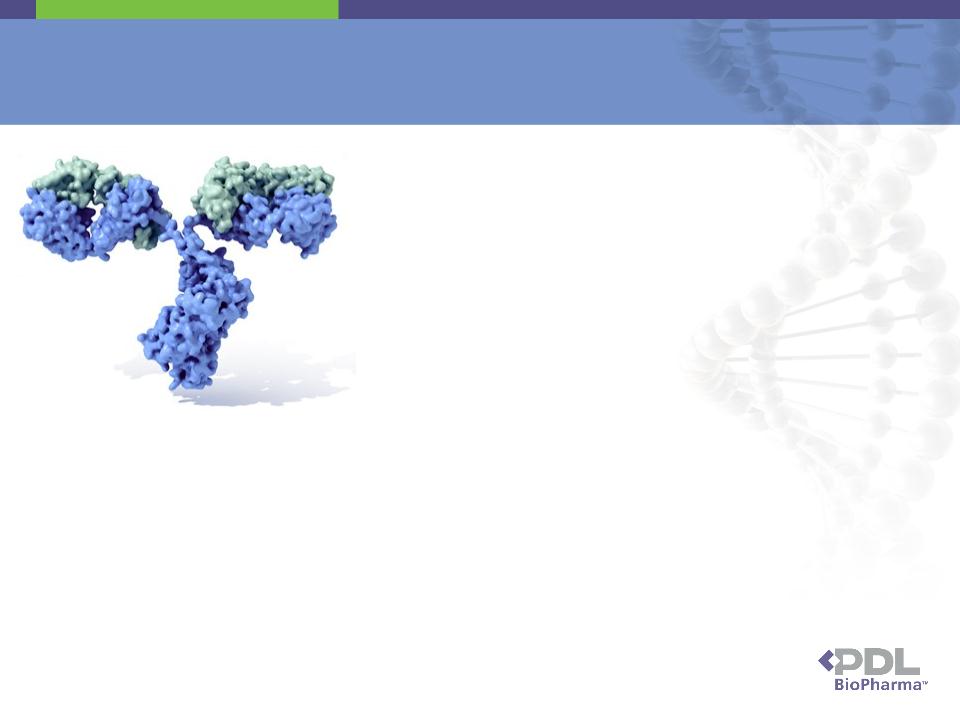
Antibody Humanization Technology
• Antibodies are naturally produced by humans to
fight foreign substances, such as bacteria and
viruses
fight foreign substances, such as bacteria and
viruses
• In the 1980’s, scientists began creating antibodies in
non-human immune systems, such as those of
mice, that could target specific sites on cells to fight
various human diseases
non-human immune systems, such as those of
mice, that could target specific sites on cells to fight
various human diseases
• However, mouse derived antibodies are recognized
by the human body as foreign substances and may
be rejected by the human immune system
by the human body as foreign substances and may
be rejected by the human immune system
6
• PDL’s technology allows for the “humanization” of mouse derived antibodies by moving
the important binding regions from the mouse antibody onto a human framework
the important binding regions from the mouse antibody onto a human framework
• PDL’s humanization technology is important because the humanized antibodies retain the
binding and activity levels from the original mouse antibody
binding and activity levels from the original mouse antibody
• PDL’s technology has been incorporated into antibodies to treat cancer, eye diseases,
arthritis, multiple sclerosis and other health conditions with aggregate annual sales of over
$17 billion
arthritis, multiple sclerosis and other health conditions with aggregate annual sales of over
$17 billion

Mission Statement
• Queen et al. Patents
▪ Manage patent portfolio
▪ Manage license agreements
• Purchase new royalty generating assets
▪ Assets that improve shareholder return
▪ Commercial stage assets
▪ Prefer biologics with strong patent protection
• Optimize return for shareholders
7

Corporate Governance
Management
• John McLaughlin
President & CEO
President & CEO
• Christine Larson
VP & CFO
VP & CFO
• Christopher Stone
VP, General Counsel &
Secretary
VP, General Counsel &
Secretary
• Caroline Krumel
VP of Finance
VP of Finance
• Danny Hart
Associate General Counsel
Associate General Counsel
Board of Directors
• Fred Frank
Lead Director
Lead Director
• Jody Lindell
• John McLaughlin
• Paul Sandman
• Harold Selick
8

Licensed Products and Royalty Revenue
9

Licensed Products and Royalty Revenue
10
1. As reported to PDL by its licensee 2. As reported by Roche; assume 1.155 CHF/USD

How Long will PDL Receive Royalties from
Queen et al. Patents?
Queen et al. Patents?
• PDL’s revenues consist of royalties generated on sales of licensed products
▪ Sold before the expiration of the Queen et al. patents in mid-2013 through end of 2014
or
▪ Made prior to the expiration of the Queen et al. patents and sold anytime thereafter
11
Example of Antibody Formulation, Fill and Finish Schedule
½ month
1 month
½ month
2-3 months
Thaw, Formulation
& Vial Filling
& Vial Filling
Quality
Release
Release
Packaging
& Quality
& Quality
Inventory
Example of Antibody Bulk Manufacturing Schedule
Cell
Culture
Quality Release
Testing
Testing
Bulk Frozen Storage
1 mo
3 mos
5 mos
10 mos
15 mos
20 mos
27 mos
3 mos
2-18 months
1mo
1mo
Purification to Concentrated Bulk/Frozen

|
Genentech Product Made or Sold in U.S.
|
|
|
Net Sales up to $1.5 Billion
|
3.0%
|
|
Net Sales Between $1.5 Billion and $2.5 Billion
|
2.5%
|
|
Net Sales Between $2.5 Billion and $4.0 Billion
|
2.0%
|
|
Net Sales Over $4.0 Billion
|
1.0%
|
|
Genentech Product Made and Sold Ex-U.S.
|
|
|
All Sales
|
3.0%
|
Queen et al Patents - Royalty Rates
12
• Tysabri and RoActemra
§ Flat, low single-digit royalty
• Genentech Products (Avastin, Herceptin, Lucentis1 and Xolair)
§ Tiered royalties on product made or sold in US
§ Flat, 3% royalty on product made and sold outside US
§ Blended global royalty rate on Genentech Products in 2010 was 1.9%
§ Blended royalty rate on Genentech Products in 2010 made or sold in US
was 1.5%
was 1.5%
1. As part of a settlement with Novartis, which commercializes Lucentis outside US, PDL agreed to pay to Novartis certain
amounts based on net sales of Lucentis made by Novartis during calendar year 2011 and beyond. The amounts to be paid are
less than we receive in royalties on such sales and we do not currently expect such amount to materially impact our total
annual revenues.
amounts based on net sales of Lucentis made by Novartis during calendar year 2011 and beyond. The amounts to be paid are
less than we receive in royalties on such sales and we do not currently expect such amount to materially impact our total
annual revenues.

Shift of Manufacturing Sites = Higher Royalties
• Roche is moving some manufacturing ex-US which may result in higher royalties
to PDL due to the flat 3% royalty for Genentech Products made and sold ex-US
to PDL due to the flat 3% royalty for Genentech Products made and sold ex-US
▪ Current production at Penzburg (Herceptin) and Basel (Avastin) plants
▪ Two new plants in Singapore (CHO = antibody and e. coli = antibody fragment)
- E. coli (Lucentis) and CHO (Avastin) plants are approved for commercial supply to the US
- E. coli and CHO plants are expected to be approved for commercial supply to the EU in 2011
- Currently, all Lucentis is made in the US
13
1. As reported to PDL by its licensee

Royalty Revenue & Licensed Products
14
Royalties by Product
($ in millions)

Royalty Products - Approved
15

Royalty Products - Avastin
16
Avastin
Herceptin
Lucentis
Xolair
Tysabri
RoActemra
ü On December 16, 2010, FDA notified
Roche/Genentech of its intention to withdraw Avastin’s
approval as first line treatment for HER2- breast cancer
in combination with paclitaxel.
Roche/Genentech of its intention to withdraw Avastin’s
approval as first line treatment for HER2- breast cancer
in combination with paclitaxel.
ü In response to request from Genentech, FDA
scheduled a hearing on June 28-29, 2011, to allow
Genentech to present why Avastin should remain FDA-
approved for HER2- breast cancer.
scheduled a hearing on June 28-29, 2011, to allow
Genentech to present why Avastin should remain FDA-
approved for HER2- breast cancer.
ü On December 16, 2010, EMEA narrowed, but did not
withdraw Avastin’s approval for first line treatment of
HER2- breast cancer in combination with paclitaxel.
withdraw Avastin’s approval for first line treatment of
HER2- breast cancer in combination with paclitaxel.
ü On April 15, 2011, Roche announced that CHMP
issued a positive opinion for the use of Avastin in
combination with Xeloda for 1st-line HER 2- breast
cancer.
issued a positive opinion for the use of Avastin in
combination with Xeloda for 1st-line HER 2- breast
cancer.
ü Roche lowered its estimate of peak annual sales from
of Avastin from CHF8 - CHF9 billion to CHF7 billion.
of Avastin from CHF8 - CHF9 billion to CHF7 billion.
ü Based on our internal model, we project Avastin for
treatment of metastatic HER2- breast cancer
represents slightly more than 2% of total PDL royalty
revenue.
treatment of metastatic HER2- breast cancer
represents slightly more than 2% of total PDL royalty
revenue.
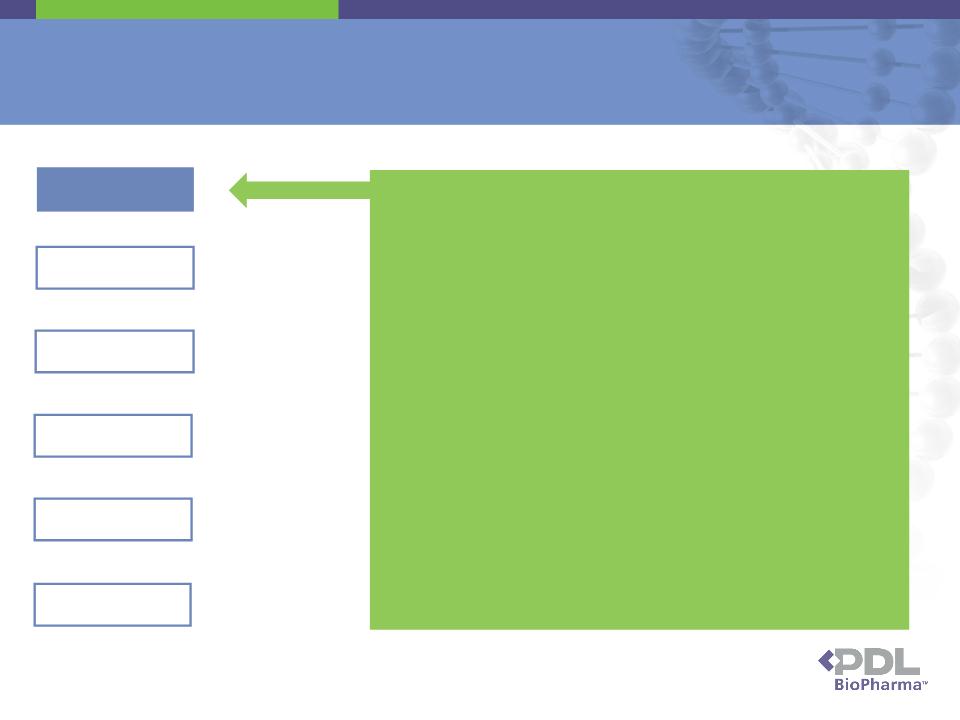
Royalty Products - Avastin
17
Avastin
Herceptin
Lucentis
Xolair
Tysabri
RoActemra
ü On June 4, 2011, Genentech announced results from
Phase 3 study evaluating Avastin in combination with
chemotherapy (gemcitabine and carboplatin) followed by
the continued use of Avastin alone in women with
previously treated (recurrent) platinum-sensitive ovarian
cancer which showed that women who received Avastin
experienced a 52 percent reduction in the risk of their
disease progressing (HR=0.48, p<0.0001) compared to
women who received chemotherapy alone.
Phase 3 study evaluating Avastin in combination with
chemotherapy (gemcitabine and carboplatin) followed by
the continued use of Avastin alone in women with
previously treated (recurrent) platinum-sensitive ovarian
cancer which showed that women who received Avastin
experienced a 52 percent reduction in the risk of their
disease progressing (HR=0.48, p<0.0001) compared to
women who received chemotherapy alone.
ü Two previous Phase 3 studies in women with newly
diagnosed ovarian cancer demonstrated that front-line
Avastin in combination with standard chemotherapy
(carboplatin and paclitaxel), followed by the continued use
of Avastin alone, significantly increased progression free
survival compared to treatment with chemotherapy alone.
diagnosed ovarian cancer demonstrated that front-line
Avastin in combination with standard chemotherapy
(carboplatin and paclitaxel), followed by the continued use
of Avastin alone, significantly increased progression free
survival compared to treatment with chemotherapy alone.
ü Roche has submitted an application for approval for first
line treatment in EU and expects a decision later in 2011.
line treatment in EU and expects a decision later in 2011.
ü Genentech expects to file an application for approval in US
in later 2011 so that it can meet FDA’s request for overall
survival data.
in later 2011 so that it can meet FDA’s request for overall
survival data.

Royalty Products - Lucentis
18
Avastin
Herceptin
Lucentis
Xolair
Tysabri
RoActemra
ü On January 7, Novartis announced that Lucentis has been
approved in the EU for the treatment of visual impairment
due to diabetic macular edema (DME).
approved in the EU for the treatment of visual impairment
due to diabetic macular edema (DME).
§ DME is a leading cause of blindness in the working-
age population in most developed countries.
age population in most developed countries.
ü On February 11, 2011, Genentech announced that one of
two Phase 3 studies evaluating in patients with DME
showed that a significantly higher percentage of patients
receiving monthly dosing of Lucentis achieved an
improvement in vision of at least 15 letters on the eye chart
at 24 months compared to those in a control group, who
received a placebo injection.
two Phase 3 studies evaluating in patients with DME
showed that a significantly higher percentage of patients
receiving monthly dosing of Lucentis achieved an
improvement in vision of at least 15 letters on the eye chart
at 24 months compared to those in a control group, who
received a placebo injection.
ü On June 6, 2011, Novartis announced that Lucentis has
been approved in the EU for the treatment of visual
impairment due to macular edema secondary to retinal vein
occlusion.
been approved in the EU for the treatment of visual
impairment due to macular edema secondary to retinal vein
occlusion.

Royalty Products - Lucentis
19
Avastin
Herceptin
Lucentis
Xolair
Tysabri
RoActemra
ü On November 22, 2010, Regeneron and Bayer reported top line
data from two Phase 3 trials investigating VEGF Trap in age-
related macular degeneration (AMD) patients which suggest that
it may be injected into the eye every other month with safety and
efficacy comparable to that of monthly dosing of Lucentis.
data from two Phase 3 trials investigating VEGF Trap in age-
related macular degeneration (AMD) patients which suggest that
it may be injected into the eye every other month with safety and
efficacy comparable to that of monthly dosing of Lucentis.
ü On December 20, 2010, Regeneron has also reported positive
Phase 3 data in the treatment of retinal vein occlusion (RVO) for
which Lucentis is approved.
Phase 3 data in the treatment of retinal vein occlusion (RVO) for
which Lucentis is approved.
§ Unlike the AMD trial, monthly administration was used in
the RVO trial, which does not afford a dosing advantage
with respect to Lucentis.
the RVO trial, which does not afford a dosing advantage
with respect to Lucentis.
ü On February 22, 2011, Regeneron and Bayer filed an
application for approval of VEGF Trap for AMD with a PDUFA
date of August 20, 2011 based on priority review. An FDA
Advisory Committee recommended approval of VEGF Trap on
June 17, 2011.
application for approval of VEGF Trap for AMD with a PDUFA
date of August 20, 2011 based on priority review. An FDA
Advisory Committee recommended approval of VEGF Trap on
June 17, 2011.
ü Regeneron filed suit in February 2011 seeking a summary
judgment that it does not infringe Genentech’s patents.
judgment that it does not infringe Genentech’s patents.
ü Genentech filed a countersuit in April 2011 asserting that
Regeneron is willfully infringing Genentech’s patents, seeking
treble damages and asking for injunctive relief.
Regeneron is willfully infringing Genentech’s patents, seeking
treble damages and asking for injunctive relief.
ü On June 7, 2011, Regeneron and Bayer filed an application for
AMD in EU.
AMD in EU.

Royalty Products - Lucentis
20
Avastin
Herceptin
Lucentis
Xolair
Tysabri
RoActemra
ü On April 4, 2011, Genentech and Johns Hopkins University
reported results of a review of files of 77,886 patients with
AMD who received either Avastin off-label or Lucentis.
reported results of a review of files of 77,886 patients with
AMD who received either Avastin off-label or Lucentis.
ü Patients receiving Avastin off-label had an 11% increased
risk of overall mortality, 57% increased risk of hemorrhagic
cerebrovascular accident, 80% more likely to have ocular
inflammation and 11% more likely to have cataract surgery
following treatment than Lucentis treated patients.
risk of overall mortality, 57% increased risk of hemorrhagic
cerebrovascular accident, 80% more likely to have ocular
inflammation and 11% more likely to have cataract surgery
following treatment than Lucentis treated patients.
ü Authors of the study note that it is limited due to incomplete
information on confounding factors such as smoking, lipid
and blood pressure levels, etc.
information on confounding factors such as smoking, lipid
and blood pressure levels, etc.

Royalty Products - Lucentis
21
Avastin
Herceptin
Lucentis
Xolair
Tysabri
RoActemra
ü On April 28, 2011, New England Journal of Medicine
reported the results from the NEI’s CATT study comparing
Lucentis and Avastin on fixed and variable schedules in the
treatment of AMD.
reported the results from the NEI’s CATT study comparing
Lucentis and Avastin on fixed and variable schedules in the
treatment of AMD.
ü Efficacy results from the first year of the two year study
showed that, with respect to the primary endpoint of mean
change in visual acuity (number of lines of letters on an eye
chart) at 12 months, less expensive Avastin was not inferior
to Lucentis.
showed that, with respect to the primary endpoint of mean
change in visual acuity (number of lines of letters on an eye
chart) at 12 months, less expensive Avastin was not inferior
to Lucentis.
§ It is estimated that off label use of Avastin in the U.S.
was 60% prior to the results of the CATT trial.
was 60% prior to the results of the CATT trial.
ü At 12 months, serious adverse events (primarily
hospitalizations) occurred at a 24% rate for patients
receiving Avastin and a 19 percent rate for patients
receiving Lucentis. However, preliminary 24 month safety
data showed no difference between Lucentis and Avastin
treated patients in terms of death, stroke and all
arteriothrombotic events.
hospitalizations) occurred at a 24% rate for patients
receiving Avastin and a 19 percent rate for patients
receiving Lucentis. However, preliminary 24 month safety
data showed no difference between Lucentis and Avastin
treated patients in terms of death, stroke and all
arteriothrombotic events.

Royalty Products - Tysabri
22
Avastin
Herceptin
Lucentis
Xolair
Tysabri
RoActemra
ü FDA and EMEA have included JC virus (JCV) status as a
risk factor for PML in the product label for Tysabri.
risk factor for PML in the product label for Tysabri.
§ The EMEA also recommended a five-year renewal of
the Tysabri’s Marketing Authorization in the EU.
the Tysabri’s Marketing Authorization in the EU.
§ EMEA Physician Info Document states that risk of
PML in:
PML in:
Ø JCV- patients is <0.2 per 1000
Ø JCV+ patients with no prior
immunosuppressants is 0.4 per 1000 in first two
years
immunosuppressants is 0.4 per 1000 in first two
years
Ø JCV+ patients with no prior
immunosuppressants is 2.6 per 1000 in years 2
-4
immunosuppressants is 2.6 per 1000 in years 2
-4
Ø JCV+ patients AND prior immunosuppressants
AND 2 or more years is 9 per 1000
AND 2 or more years is 9 per 1000
Ø JCV+ = roughly 55% of MS population
ü Based on May 2011 patient numbers, the highest monthly
new starts in over a year, the JCV assay allows physicians
to prescribe the most efficacious multiple sclerosis drug and
derisks the likelihood of PML by halting Tysabri treatment in
patients who are JCV+.
new starts in over a year, the JCV assay allows physicians
to prescribe the most efficacious multiple sclerosis drug and
derisks the likelihood of PML by halting Tysabri treatment in
patients who are JCV+.

Royalty Products - RoActemra
23
Avastin
Herceptin
Lucentis
Xolair
Tysabri
RoActemra
ü On January 5, 2011, Roche announced that FDA expanded
the RoActemra label to include inhibition and slowing of
structural joint damage, improvement of physical function,
and achievement of major clinical response in adult patients
with moderately to severely active rheumatoid arthritis.
the RoActemra label to include inhibition and slowing of
structural joint damage, improvement of physical function,
and achievement of major clinical response in adult patients
with moderately to severely active rheumatoid arthritis.
ü On April 18, 2011, FDA approved RoActemra to treat
patients age 2 and older with active systemic juvenile
idiopathic arthritis (SJIA).
patients age 2 and older with active systemic juvenile
idiopathic arthritis (SJIA).
§ It is the first and only approved treatment for SJIA, a
rare and severe form of arthritis affecting children.
rare and severe form of arthritis affecting children.

Potential Royalty Products
- Development Stage
- Development Stage
24

Potential Royalty Products - T-DM1
25
T-DM1
Breast HER2+ Cancer
ü On October 13, 2010, Roche/Genentech announced
preliminary, six month results from a Phase 3 trial in second
line HER2+ breast cancer patients which showed that 48%
of women treated with T-DM1 had their tumors shrink
compared with 41% of those taking the combination of
Herceptin and Taxotere.
preliminary, six month results from a Phase 3 trial in second
line HER2+ breast cancer patients which showed that 48%
of women treated with T-DM1 had their tumors shrink
compared with 41% of those taking the combination of
Herceptin and Taxotere.
§ Among the women taking the standard therapy, 75%
had side effects of grade 3 or higher on a 5-point
scale, compared with 37% of those getting T-DM1.
had side effects of grade 3 or higher on a 5-point
scale, compared with 37% of those getting T-DM1.
ü Roche/Genentech expect to file for second line approval in
2012.
2012.
Ocrelizumab
Multiple Sclerosis
Pertuzumab
Breast HER2+ Cancer
Afutuzumab
Chronic Lymphocytic
Leukemia
Leukemia
Solanezumab
Alzheimer’s Disease
Daclizumab
Multiple Sclerosis
Datoluzumab
Colorectal Cancer
Bapineuzumab
Alzheimer’s Disease
Farletuzumab
Ovarian Cancer

Potential Royalty Products - Ocrelizumab
26
T-DM1
Breast HER2+ Cancer
ü Phase 2b.
ü Unlicensed product.
Ocrelizumab
Multiple Sclerosis
Pertuzumab
Breast HER2+ Cancer
Afutuzumab
Chronic Lymphocytic
Leukemia
Leukemia
Solanezumab
Alzheimer’s Disease
Daclizumab
Multiple Sclerosis
Datoluzumab
Colorectal Cancer
Bapineuzumab
Alzheimer’s Disease
Farletuzumab
Ovarian Cancer

Potential Royalty Products - Pertuzumab
27
T-DM1
Breast HER2+ Cancer
ü On December 10, 2010, Roche/Genentech reported the
results from a Phase 2 trial investigating the neoadjuvant
(prior to surgery) use of pertuzumab and Herceptin plus
chemotherapy for the treatment of early-stage, HER2+
breast cancer.
results from a Phase 2 trial investigating the neoadjuvant
(prior to surgery) use of pertuzumab and Herceptin plus
chemotherapy for the treatment of early-stage, HER2+
breast cancer.
ü Treatment significantly improved the rate of complete tumor
disappearance in the breast by more than half compared to
Herceptin plus docetaxel, p=0.014.
disappearance in the breast by more than half compared to
Herceptin plus docetaxel, p=0.014.
ü Roche/Genentech expect to file for approval at the end of
2011.
2011.
ü Unlicensed product.
Ocrelizumab
Multiple Sclerosis
Pertuzumab
Breast HER2+ Cancer
Afutuzumab
Chronic Lymphocytic
Leukemia
Leukemia
Solanezumab
Alzheimer’s Disease
Daclizumab
Multiple Sclerosis
Datoluzumab
Colorectal Cancer
Bapineuzumab
Alzheimer’s Disease
Farletuzumab
Ovarian Cancer

Potential Royalty Products - Afutuzumab
28
T-DM1
Breast HER2+ Cancer
ü Phase 3.
ü Roche/Genentech expect to file for approval in 2013.
Ocrelizumab
Multiple Sclerosis
Pertuzumab
Breast HER2+ Cancer
Afutuzumab
Chronic Lymphocytic
Leukemia
Leukemia
Solanezumab
Alzheimer’s Disease
Daclizumab
Multiple Sclerosis
Datoluzumab
Colorectal Cancer
Bapineuzumab
Alzheimer’s Disease
Farletuzumab
Ovarian Cancer

Potential Royalty Products - Bapineuzumab
29
T-DM1
Breast HER2+ Cancer
ü Phase 3.
ü Data expected in 2H012.
Ocrelizumab
Multiple Sclerosis
Pertuzumab
Breast HER2+ Cancer
Afutuzumab
Chronic Lymphocytic
Leukemia
Leukemia
Solanezumab
Alzheimer’s Disease
Daclizumab
Multiple Sclerosis
Datoluzumab
Colorectal Cancer
Bapineuzumab
Alzheimer’s Disease
Farletuzumab
Ovarian Cancer
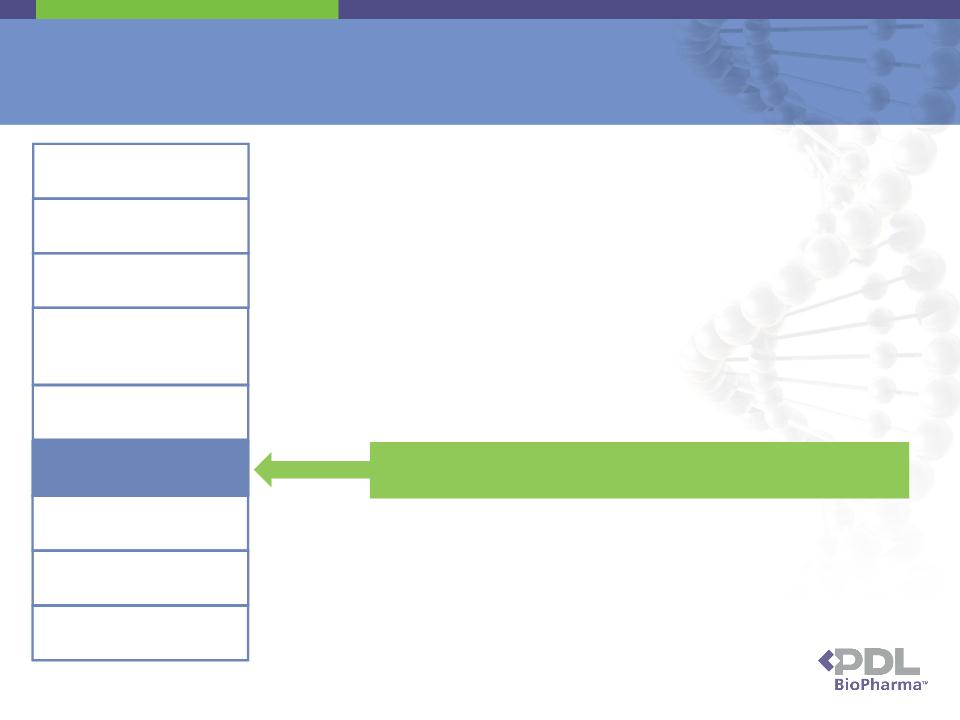
Potential Royalty Products - Solanezumab
30
T-DM1
Breast HER2+ Cancer
ü Phase 3.
ü Data expected in 2H012.
Ocrelizumab
Multiple Sclerosis
Pertuzumab
Breast HER2+ Cancer
Afutuzumab
Chronic Lymphocytic
Leukemia
Leukemia
Solanezumab
Alzheimer’s Disease
Daclizumab
Multiple Sclerosis
Datoluzumab
Colorectal Cancer
Bapineuzumab
Alzheimer’s Disease
Farletuzumab
Ovarian Cancer
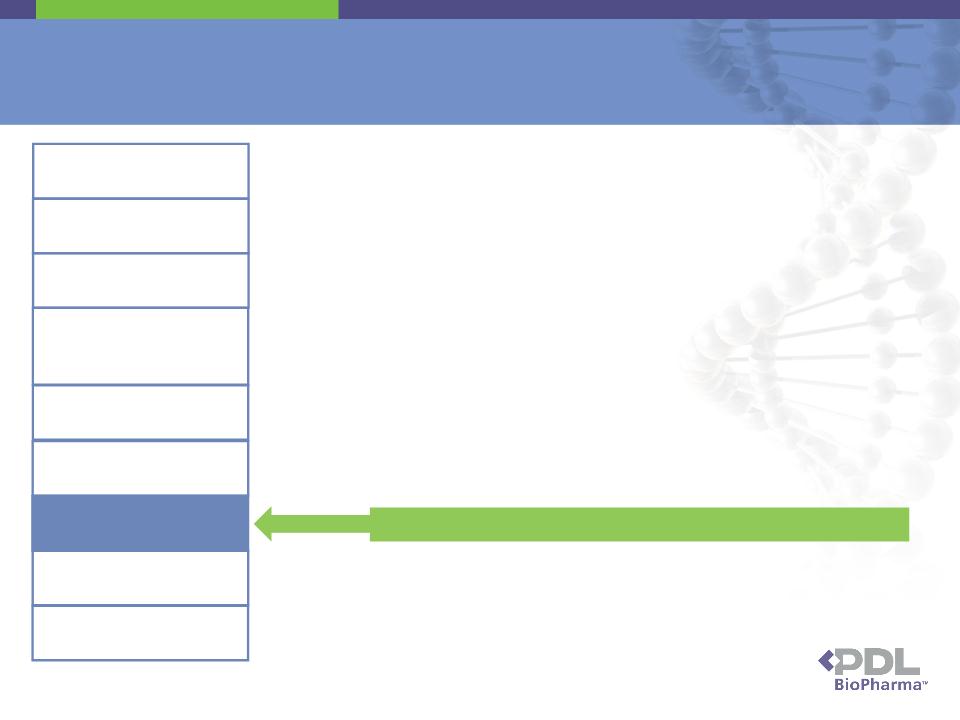
Potential Royalty Products - Datoluzumab
31
T-DM1
Breast HER2+ Cancer
ü Phase 2.
Ocrelizumab
Multiple Sclerosis
Pertuzumab
Breast HER2+ Cancer
Afutuzumab
Chronic Lymphocytic
Leukemia
Leukemia
Solanezumab
Alzheimer’s Disease
Daclizumab
Multiple Sclerosis
Datoluzumab
Colorectal Cancer
Bapineuzumab
Alzheimer’s Disease
Farletuzumab
Ovarian Cancer
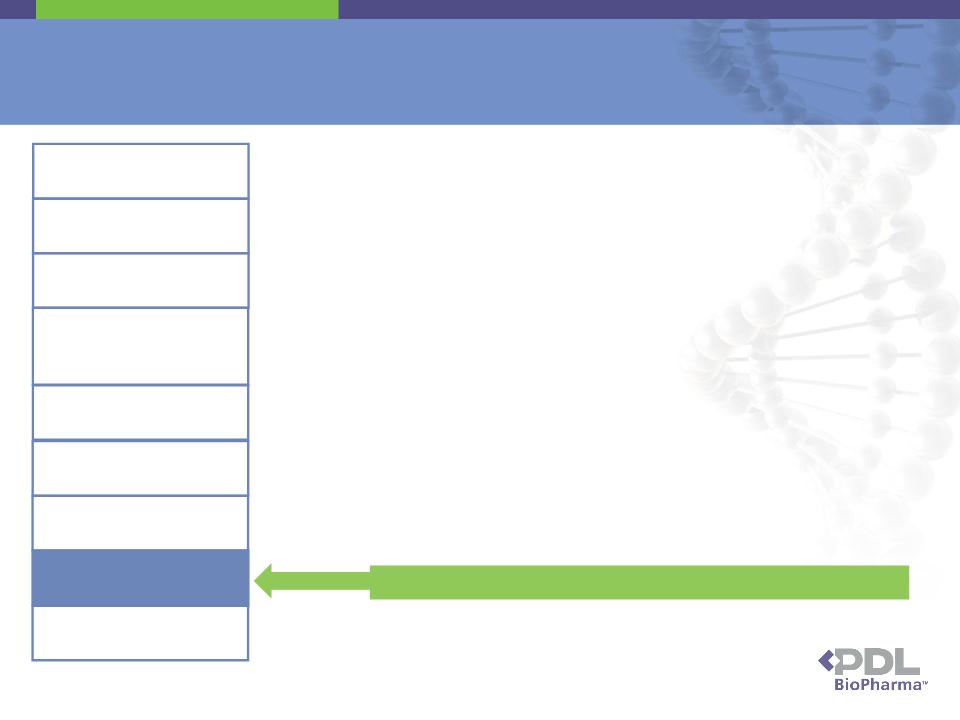
Potential Royalty Products - Daclizumab
32
T-DM1
Breast HER2+ Cancer
ü Phase 3.
Ocrelizumab
Multiple Sclerosis
Pertuzumab
Breast HER2+ Cancer
Afutuzumab
Chronic Lymphocytic
Leukemia
Leukemia
Solanezumab
Alzheimer’s Disease
Daclizumab
Multiple Sclerosis
Datoluzumab
Colorectal Cancer
Bapineuzumab
Alzheimer’s Disease
Farletuzumab
Ovarian Cancer
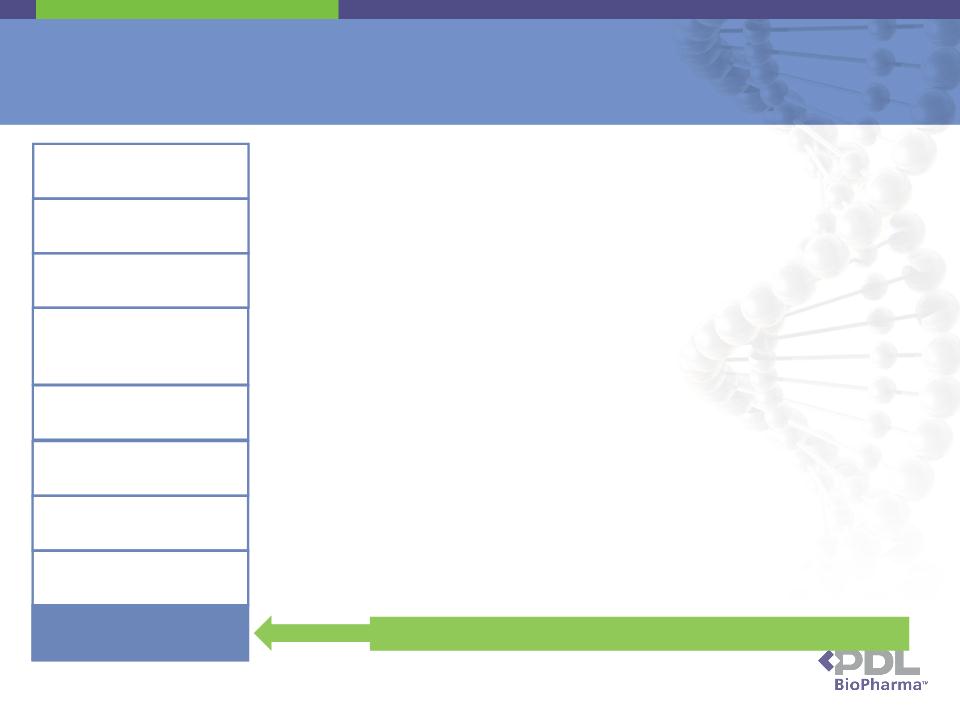
Potential Royalty Products - Farletuzumab
33
T-DM1
Breast HER2+ Cancer
ü Phase 3.
Ocrelizumab
Multiple Sclerosis
Pertuzumab
Breast HER2+ Cancer
Afutuzumab
Chronic Lymphocytic
Leukemia
Leukemia
Solanezumab
Alzheimer’s Disease
Daclizumab
Multiple Sclerosis
Datoluzumab
Colorectal Cancer
Bapineuzumab
Alzheimer’s Disease
Farletuzumab
Ovarian Cancer
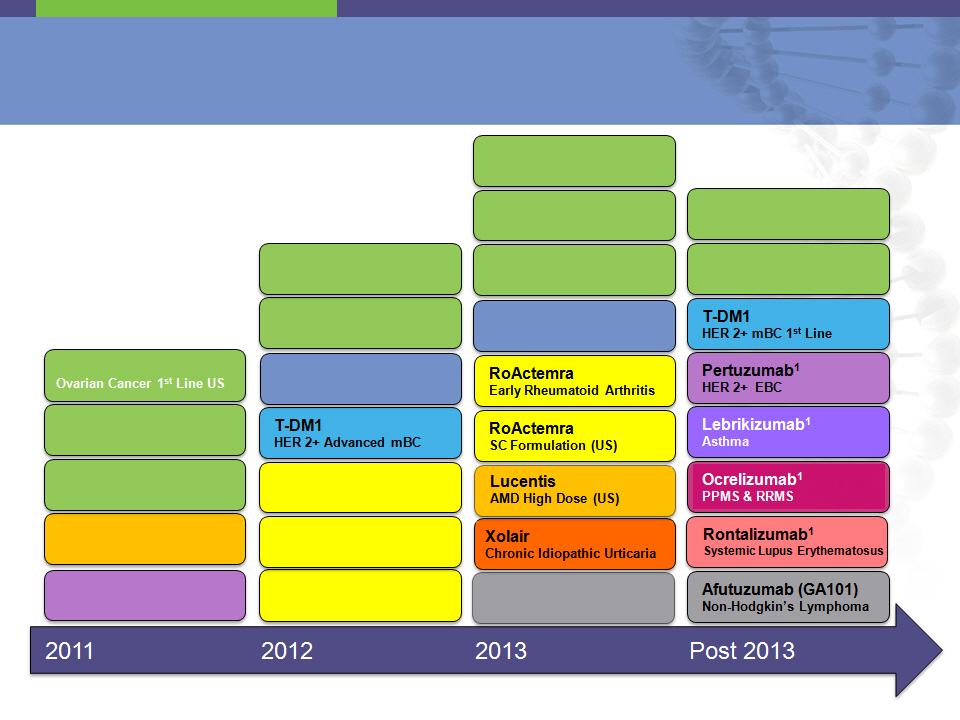
Genentech / Roche - Product Pipeline
34
Avastin
Lucentis
Diabetic Macular Edema (US)
Pertuzumab1
mBC HER2+ 1st Line
Avastin + Herceptin
mBC HER+ 2nd Line
Avastin
Relapsed Ovarian Cancer
RoActemra
RA DMARD H2H (EU)
RoActemra
Ankylosing Spondylitis
Herceptin
Subcutaneous Formulation
Avastin & Herceptin
HER2+ mBC 1st Line
Avastin
mCRC TML
RoActemra
SC Formulation (EU)
Afutuzumab (GA101)
Chronic Lymphocytic Leukemia
Avastin
BC Adjuvant HER2+
Avastin
BC Adj Triple Negative
Herceptin
BC HER 2+ Adj 2 Year
Avastin
Glioblastoma 1st Line
Avastin
HER 2- BC adj
Avastin
NSCLC adj
1. Not a licensed product
Source: Roche investor update, April 14, 2011
US & EU Filings Calendar

Financials
35

Financial Overview
36
1. Includes $92.5 million one time legal settlement to MedImmune. Net interest expense
includes $17.6 million loss on convertible note retirement.
includes $17.6 million loss on convertible note retirement.
2. Includes $10.0 million one time legal settlement from UCB.
2009
2010
1Q-2011
2
2Q-2011 YTD
12/31/2010
3/31/2011
Revenue
318
$
345
$
83
$
205
$
Cash, Cash Equivalents
Expenses
21
134
6
& Investments
248
$
193
$
EBIT
Total Assets
317
$
249
$
Net Interest Expense
17
61
9
Pre-Tax Profit
Total Debt
518
$
497
$
Taxes
91
58
24
Total Stockholders' Deficit
(324)
$
(371)
$
Net Income

Debt
37
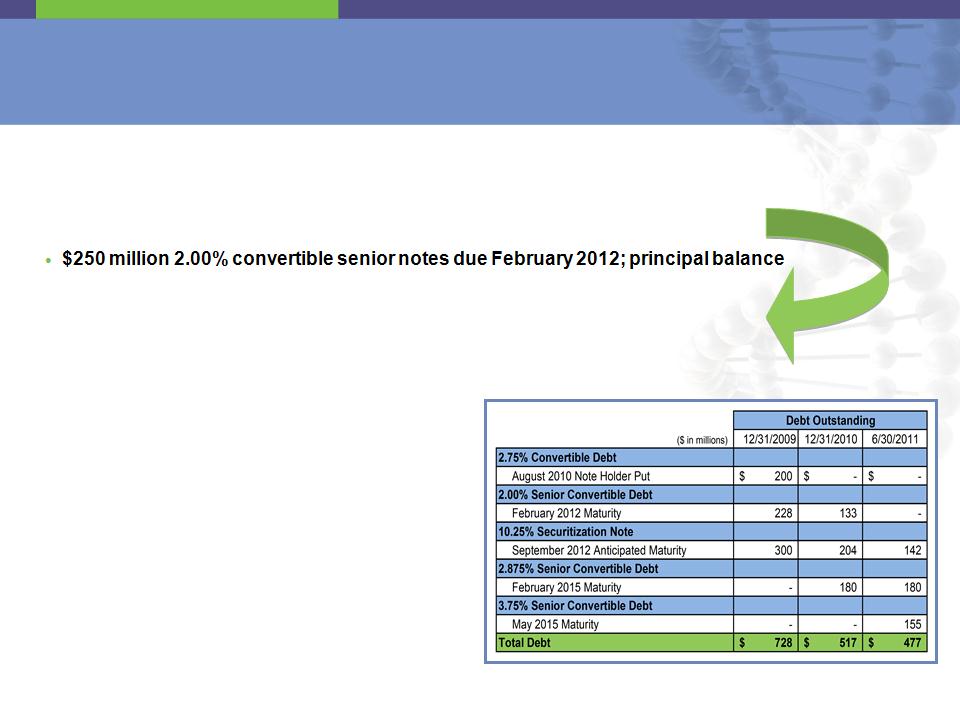
Current and Long-Term Liabilities
• $155 million 3.75% convertible senior notes due May 2015
▪ Notes issued May 16, 2011; conversion rate is 129.2740 / $1,000 face amount ($7.74/share)
▪ Bond hedge effectively increases conversion price to $9.10 / share
▪ Proceeds will be used to redeem 2012 convertible senior notes as of June 30, 2011
of $133 million
▪ Conversion rate is 147.887 shares / $1,000 face amount ($6.76/share)
▪ Redemption date is June 30, 2011, subject to note holders’ conversion rights
38
• $180 million 2.875% convertible senior notes
due February 2015
due February 2015
▪ Conversion rate is 147.887 shares / $1,000
face amount ($6.76/share)
face amount ($6.76/share)
• $300 million 10.25% secured non-recourse
notes; principal balance of $142 million as of
June 30, 2011
notes; principal balance of $142 million as of
June 30, 2011
▪ Approximately 40% of Genentech royalties
dedicated to quarterly principal and interest
dedicated to quarterly principal and interest
▪ After retirement, securitized Genentech
royalties will be retained by PDL
royalties will be retained by PDL
• The purpose of restructuring PDL’s debt is to
free up cash for the acquisition of royalty
assets
free up cash for the acquisition of royalty
assets

Legal Matters
39

Recent Resolution of Legal Disputes
• PDL has resolved all challenges to the Queen et al. Patents in the
U.S. Patent and Trademark Office (USPTO) and the European
Patent Office (EPO) as well as its dispute with MedImmune
U.S. Patent and Trademark Office (USPTO) and the European
Patent Office (EPO) as well as its dispute with MedImmune
▪ UCB Pharma
- PDL received $10 million from UCB and PDL agreed not to sue UCB for any royalties
related to Cimzia
related to Cimzia
- UCB terminated patent interference proceedings before the USPTO and withdrew its
opposition appeal in the EPO
opposition appeal in the EPO
▪ MedImmune
- PDL paid MedImmune $65 million on February 15, 2011, and will pay them an additional
$27.5 million by February 2012
$27.5 million by February 2012
- MedImmune ceased support of any party in the EPO opposition appeal
▪ Novartis
- PDL dismissed its claims against Novartis in its Nevada lawsuit
- Novartis withdrew its opposition appeal to PDL’s European patent in EPO
- Beginning in 2Q11, PDL will pay Novartis an amount based on Novartis’ net ex-U.S. sales
of Lucentis during calendar year 2011 and beyond
of Lucentis during calendar year 2011 and beyond
▪ BioTransplant
- PDL acquired BioTransplant, a bankrupt company and instructed BioTransplant to
withdraw its opposition appeal in the EPO
withdraw its opposition appeal in the EPO
40

Pending Dispute with Genentech and Roche
• In August 2010, Genentech sent a fax on behalf of Roche and Novartis
asserting its products do not infringe PDL’s supplementary protection
certificates (SPCs)
asserting its products do not infringe PDL’s supplementary protection
certificates (SPCs)
▪ Products include Avastin, Herceptin, Lucentis and Xolair
▪ SPCs are extensions of patent term in Europe that are issued on a country-by-country
and product-by-product basis
and product-by-product basis
• PDL Response
▪ Genentech’s assertions are without merit
▪ PDL disagrees with Genentech’s assertions of non-infringement
▪ Genentech had waived its rights to challenge our patents, including SPCs in its 2003
Settlement Agreement with PDL
Settlement Agreement with PDL
• 2003 Settlement Agreement
▪ Resolved intellectual property disputes between the two companies at that time
▪ Limits Genentech’s ability to challenge infringement of PDL’s patent rights, including
SPCs, and waives Genentech’s right to challenge or assist other in challenging the
validity of our patent rights
SPCs, and waives Genentech’s right to challenge or assist other in challenging the
validity of our patent rights
41

Nevada Lawsuit Against Genentech/Roche
• PDL filed a lawsuit against Genentech and Roche in Nevada
state court
state court
▪ Lawsuit states that fax constitutes a breach of 2003 Settlement
Agreement because Genentech assisted Roche in challenging PDL’s
patents and SPCs
Agreement because Genentech assisted Roche in challenging PDL’s
patents and SPCs
▪ Complaint seeks compensatory damages, including liquidated damages
and other monetary remedies set forth in the 2003 Settlement
Agreement, punitive damages and attorney’s fees
and other monetary remedies set forth in the 2003 Settlement
Agreement, punitive damages and attorney’s fees
• In November 2010, Genentech and Roche filed two motions
to dismiss
to dismiss
▪ They contend that 2003 Settlement Agreement applies only to PDL’s
U.S. patent rights
U.S. patent rights
▪ They asserted that the Nevada court lacks personal jurisdiction over
Roche
Roche
▪ On April 21, 2011, Nevada court heard arguments on two Genentech
and Roche motions
and Roche motions
▪ If case proceeds, trial is not yet scheduled and not expected until 2012
42

Optimizing Stockholder Return
43

Business Strategy
• Purchase new royalty assets and
ladder like a bond portfolio
ladder like a bond portfolio
▪ Continue to reinvest in new royalty
assets and pay dividends
assets and pay dividends
- Commercial stage products
- Sweet spot $75MM to $150MM
▪ Debt repaid by end of 2015
▪ Company continues as long as it
can generate satisfactory return
can generate satisfactory return
• If unable to acquire royalty assets
on attractive terms, build cash
reserves to:
on attractive terms, build cash
reserves to:
▪ Repay debt
▪ Use all excess cash to pay
dividends to enhance shareholder
return
dividends to enhance shareholder
return
▪ Wind-up company in 2016
timeframe
timeframe
44
• Queen et al. patents expire end of 2014;
we anticipate royalties will likely
continue to ~2016
we anticipate royalties will likely
continue to ~2016
• PDL has two possible future pathways

Optimizing Stockholder Return
• Continuously evaluating alternatives
▪ Dividends
▪ Capital restructure
▪ Share repurchase
▪ Company sale
▪ Purchase of commercial stage, royalty
generating assets
generating assets
45
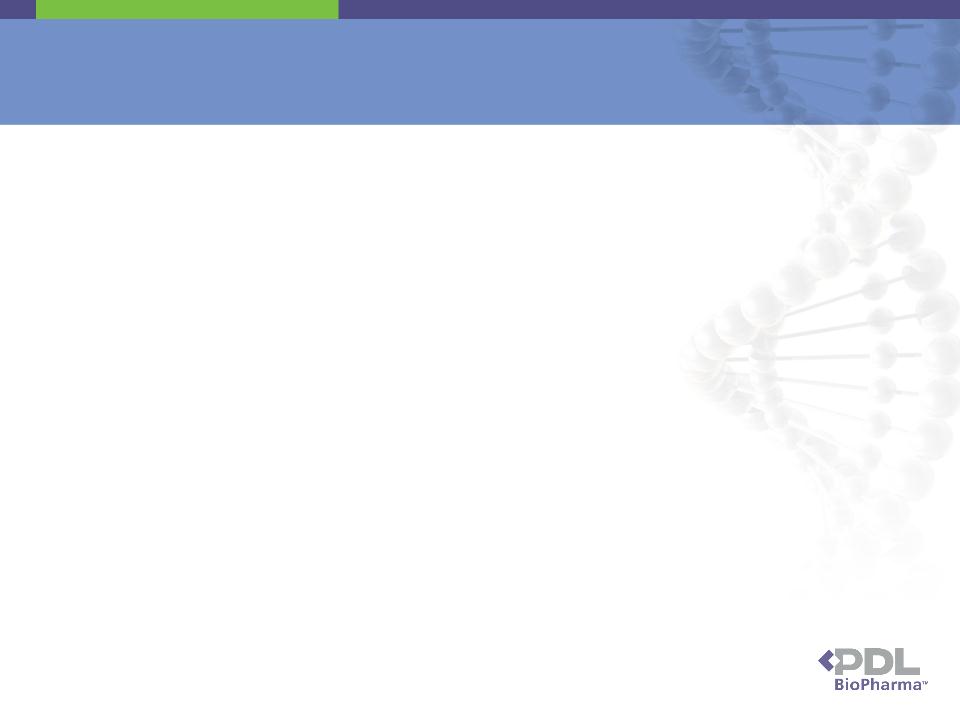
Investment Highlights
• Strong historic revenue growth from approved products
• Potential for additional indications from existing
products, new product approvals and purchase of new
royalty assets
products, new product approvals and purchase of new
royalty assets
• Potential to grow and diversify revenues with the
addition of new royalty assets
addition of new royalty assets
• Significantly reduced expenses with no R&D burn
• Liquidity - volume averages 3 million shares/day
• Return to stockholders
▪ In 2011, $0.60/share to be paid in quarterly regular dividends of
$0.15/share in March 15, June 15, September 15 and
December 15
$0.15/share in March 15, June 15, September 15 and
December 15
46

Appendix
47

Avastin
• Licensor
▪ Genentech (US) and Roche (ex-US)
• Mechanism
▪ As a tumor grows, it exceeds the ability of the local
blood supply to nourish it
blood supply to nourish it
▪ Tumor causes up regulation of vascular endothelial
growth factor (VEGF) stimulating angiogenesis or the
growth of leaky blood vessels to nourish the tumor
growth factor (VEGF) stimulating angiogenesis or the
growth of leaky blood vessels to nourish the tumor
▪ Avastin targets and inhibits VEGF reduction in blood
vessels “starving” the tumor
vessels “starving” the tumor
• Approvals
▪ Metastatic colorectal cancer, advanced non-small cell
lung cancer, renal cancer, metastatic HER2- breast
cancer and glioblastoma
lung cancer, renal cancer, metastatic HER2- breast
cancer and glioblastoma
• Sales
▪ 2010 worldwide net sales of $6.4 billion1
- US is reviewing approval for metastatic HER2- breast cancer and EU
has narrowed this label, resulting in drop in sales for this indication
has narrowed this label, resulting in drop in sales for this indication
48
Treatment with Avastin
reduces vascularization
or blood supply of tumor
reduces vascularization
or blood supply of tumor
1. As reported to PDL by its licensee
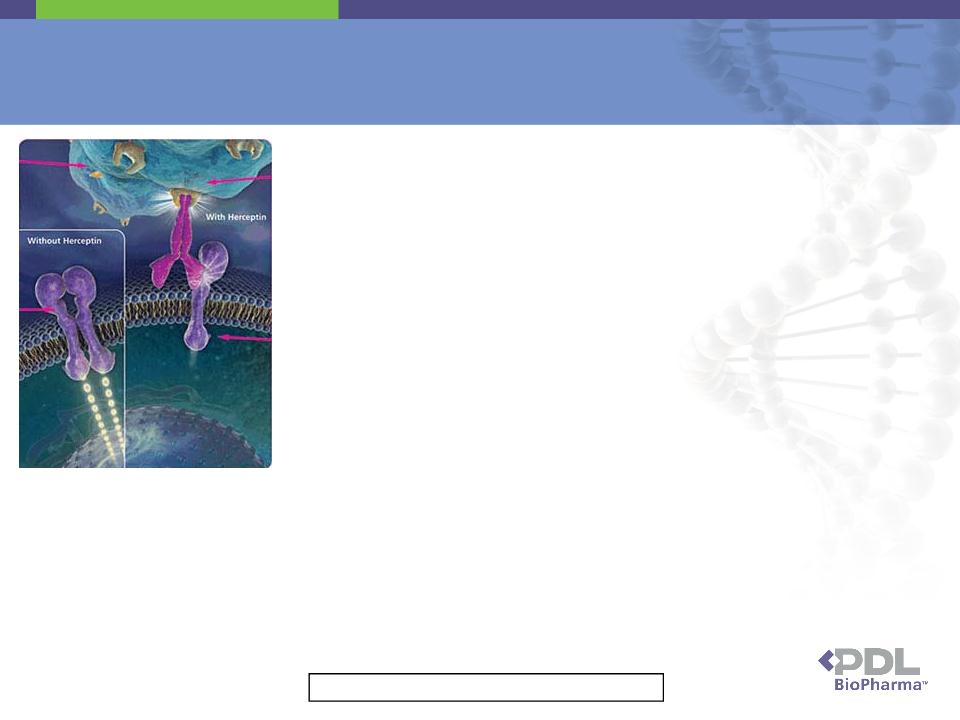
Herceptin
• Licensor
▪ Genentech (US) and Roche (ex-US)
• Mechanism
▪ Some breast cancer cells make too many (over-express)
copies of a particular gene known as HER2 that causes
rapid growth of the breast cancer cell
copies of a particular gene known as HER2 that causes
rapid growth of the breast cancer cell
▪ Herceptin works by attaching itself to the HER2
receptors on the surface of breast cancer cells, blocking
them from receiving growth signals and slowing or
stopping the growth of the breast cancer cell
receptors on the surface of breast cancer cells, blocking
them from receiving growth signals and slowing or
stopping the growth of the breast cancer cell
▪ Herceptin also fights breast cancer by alerting the
immune system to destroy cancer cells onto which it is
attached
immune system to destroy cancer cells onto which it is
attached
• Approvals
▪ Metastatic HER2+ breast cancer, metastatic HER2+
stomach cancer
stomach cancer
• Sales
▪ 2010 worldwide net sales of $5.4 billion1
49
Without Herceptin treatment,
cell surface receptors signal
into the HER2+ breast cancer
cell to proliferate
cell surface receptors signal
into the HER2+ breast cancer
cell to proliferate
Herceptin binds to cell surface
receptors inhibiting
intracellular signals thus
preventing cancer cell
proliferation and signaling the
immune system to “kill” the
cancer cell
receptors inhibiting
intracellular signals thus
preventing cancer cell
proliferation and signaling the
immune system to “kill” the
cancer cell
1. As reported to PDL by its licensee

Lucentis
50
• Licensor
▪ Genentech (US) and Novartis (ex-US)
• Mechanism
▪ A form of VEGF known as VEGF-A causes the
formation of leaky blood vessels result in the
swelling in the macula and vision loss
formation of leaky blood vessels result in the
swelling in the macula and vision loss
▪ Lucentis binds to and inhibits VEGF-A before it
can cause the formation of the leaky blood vessels
preserving and sometimes improving vision
can cause the formation of the leaky blood vessels
preserving and sometimes improving vision
• Approvals
▪ Wet age-related macular degeneration (AMD),
macular edema or swelling following retinal vein
occlusion, diabetic macular edema
macular edema or swelling following retinal vein
occlusion, diabetic macular edema
• Sales
▪ 2010 worldwide net sales of $3.0 billion1
- Recent NIH study comparing safety and effectiveness
of Lucentis finds less expensive Avastin equally
efficacious - will adversely affect future Lucentis sales
for AMD
of Lucentis finds less expensive Avastin equally
efficacious - will adversely affect future Lucentis sales
for AMD
- It’s estimated that in the U.S. 60% of AMD patients are
already treated with off-label Avastin
already treated with off-label Avastin
Cross
section of
normal
macula at
back of eye
section of
normal
macula at
back of eye
Cross
section of
macula with
AMD causing
loss of vision
section of
macula with
AMD causing
loss of vision
Amsler Grid as
seen through
normal eyes
seen through
normal eyes
Amsler Grid as
seen through
eyes with AMD
seen through
eyes with AMD
1. As reported to PDL by its licensee
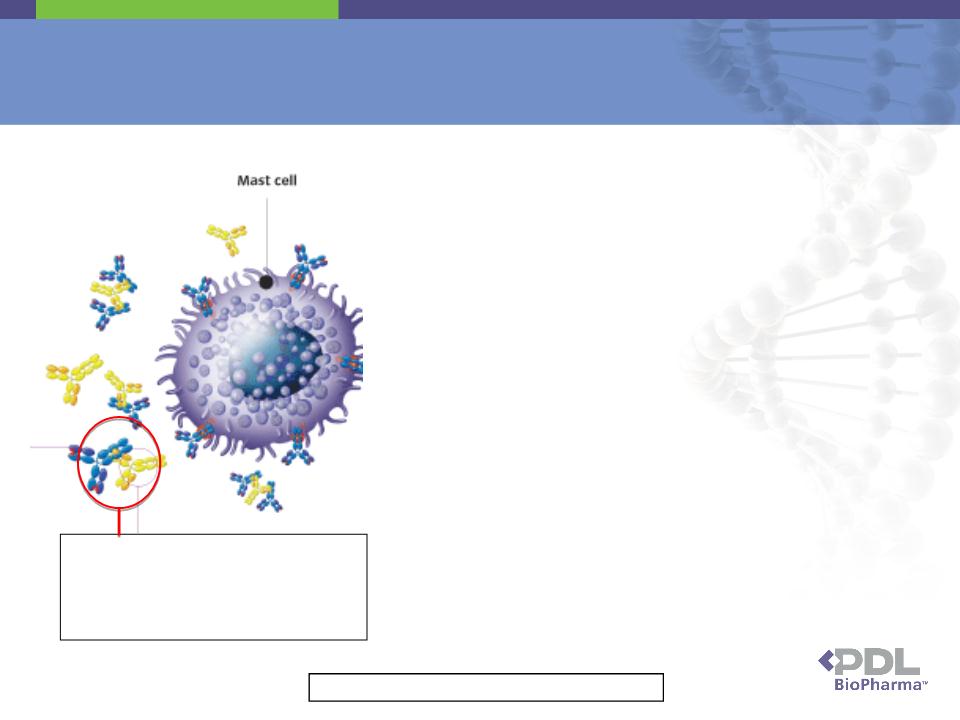
Xolair
51
• Licensor
▪ Genentech (US) and Novartis (ex-US)
• Mechanism
▪ IgE plays a role in allergic disease by
causing the release of inflammatory
mediators from mast cells that result in
sneezing, wheezing and asthma
causing the release of inflammatory
mediators from mast cells that result in
sneezing, wheezing and asthma
▪ Xolair binds to and neutralizes circulating
IgE by preventing IgE from binding to its
mast-cell receptor
IgE by preventing IgE from binding to its
mast-cell receptor
• Approvals
▪ Moderate-to-severe persistent asthma
• Sales
▪ 2010 worldwide net sales of $1.0 billion1
Xolair antibody (yellow) binds to IgE
(blue) preventing IgE from binding to
mast cell. Otherwise, IgE binding to
mast cell would result in wheezing,
sneezing and asthma.
(blue) preventing IgE from binding to
mast cell. Otherwise, IgE binding to
mast cell would result in wheezing,
sneezing and asthma.
1. As reported to PDL by its licensee
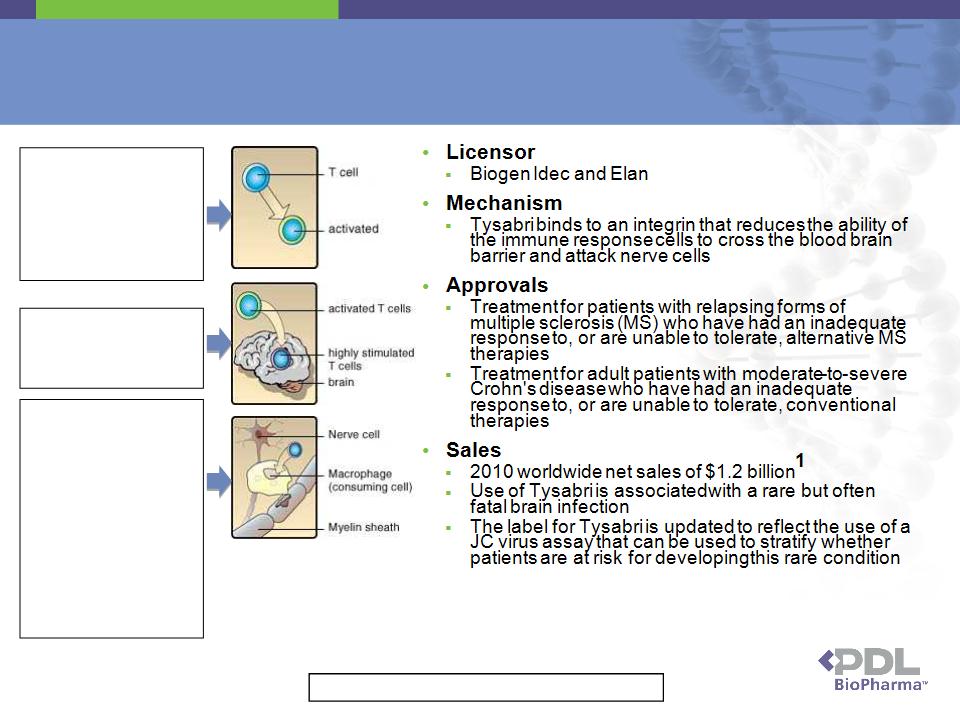
Tysabri
52
▪ EU authorities have renewed Tysabri’s approval for
the typical five year period
the typical five year period
In MS, the body’s
autoimmune system is
inappropriately activated,
resulting in it attacking
the body. Here, defense
cells, known as T cells,
are activated.
autoimmune system is
inappropriately activated,
resulting in it attacking
the body. Here, defense
cells, known as T cells,
are activated.
Activated T cells are able
to cross the blood brain
barrier affording them
access to nerve cells.
to cross the blood brain
barrier affording them
access to nerve cells.
Activated T cells attack,
and recruit other defense
cells known as
macrophages, to attack
and consume the myelin
sheath or insulation
surrounding nerve fibers.
The resulting holes in the
myelin slow the
transmission of impulses
along the nerve and
cause the symptoms of
MS.
and recruit other defense
cells known as
macrophages, to attack
and consume the myelin
sheath or insulation
surrounding nerve fibers.
The resulting holes in the
myelin slow the
transmission of impulses
along the nerve and
cause the symptoms of
MS.
1. As reported to PDL by its licensee

RoActemra
53
• Licensor
▪ Roche and Chugai
• Mechanism
▪ Rheumatoid arthritis (RA) is an autoimmune disease in
which the body's immune system attacks itself
which the body's immune system attacks itself
▪ One of the defense mechanisms inappropriately
activated in RA is IL-6, which can result in destruction of
the cartilage between joints causing the symptoms of
RA
activated in RA is IL-6, which can result in destruction of
the cartilage between joints causing the symptoms of
RA
▪ RoActemra binds to and neutralizes IL-6 preventing it
from destroying cartilage thereby blocking one of the
causes of RA
from destroying cartilage thereby blocking one of the
causes of RA
• Approvals
▪ Treatment of signs and symptoms in moderate-to-
severe adult RA patients, slowing of structural damage
to joints caused by RA and preservation physical
function of joints afflicted by RA
severe adult RA patients, slowing of structural damage
to joints caused by RA and preservation physical
function of joints afflicted by RA
• Sales
▪ 2010 worldwide net sales of $459 million1
It is the degradation and
eventual destruction of this
cartilage that causes the
symptoms of RA.
eventual destruction of this
cartilage that causes the
symptoms of RA.
1. As reported by Roche; assume 1.155 CHF/USD
